Entomophily
Last updated
Entomophily operating theatre insect pollination is a form of pollination whereby pollen of plants, particularly but not only of flowering plants, is far-flung by insects. Flowers pollinated by insects typically advertise themselves with bright colours, sometimes with rank patterns (dearest guides) leading to rewards of pollen and ambrosia; they Crataegus laevigata too have an cunning scent which in few cases mimics insect pheromones. Insect pollinators much as bees have adaptations for their role, such as imbrication or sucking mouthparts to take in nectar, and in some species too pollen baskets along their hind legs. This needed the coevolution of insects and flowering plants in the developing of pollination behaviour by the insects and pollination mechanisms by the flowers, benefiting both groups.
- Coevolution
- History
- The establish's needs
- Mechanisms
- Plant-louse pairings
- Etymology
- Taxonomic range
- See also
- References
Coevolution
History

The early spermatophytes (seed plants) were largely conditional the wind to carry their pollen from united plant to another. Prior to the appearance of flowering plants some gymnosperms, such as Bennettitales, developed flower-the likes of structures that were likely louse pollinated. Insects pollination for gymnosperms likely originated in the Permian. [1] Candidates for pollinators include extinct long proboscis dirt ball groups, including Aneuretopsychid, Mesopsychid and Pseudopolycentropodid scorpionflies, [2] Kalligrammatid [3] [4] and Paradoxosisyrine [5] lacewings and Zhangsolvid flies, [6] besides as approximately extant families that specialistic on gymnosperms before switching to angiosperms, including Nemestrinid, Tabanid and Acrocerid flies. [7] Living cycads birth mutualistic relationships with specific insect species (typically beetles) which cross-pollinate them. Such relationships protract back to at to the lowest degree the late Age of Reptiles, with both oedemerid beetles (which today are exclusively found on flowering plants) [1] and boganiid beetles [8] (which still cross-pollinate cycads now) from the Geological period being found with preserved cycad pollen. Angiosperms (unfolding plants) first appeared during the Early Cretaceous, and during the angiosperm radiation from 125 to 90 Ma, would displace many of the gymnosperm lineages and causal agency the extinction of umteen of their pollinators, while some would transition to angiosperms and roughly new families would frame pollenation associations with angiosperms. [1] Traits such As sapromyophily (emitting the odour of carrion to attract flies) have evolved independently in several unrelated angiosperm families. [9]
The plant's needs
Wind and water pollination take the production of vast quantities of pollen because of the uncertain nature of its deposition. If they are not to be reliant on the wind or body of water (for aquatic species), plants ask pollinators to actuate their pollen grains from one embed to other. They particularly need pollinators to consistently take flowers of the same species, so they have evolved different lures to encourage proper pollinators to maintain fidelity to the same species. The attractions offered are mainly nectar, pollen, fragrances and oils. The ideal pollinating insect is hairy (so that pollen adheres to information technology), and spends time exploring the flower so that it comes into impinging with the reproductive structures. [10]
Mechanisms
Many insects are pollinators, particularly bees, Order Lepidoptera (butterflies and moths), wasps, flies, ants and beetles. [10] Connected the otherwise bridge player, some plants are generalists, being pollinated by insects in different orders. [11] Entomophilous plant species have frequently evolved mechanisms to make themselves more imploring to insects, e.g., brilliantly coloured or scented flowers, ambrosia, or appealing shapes and patterns. Pollen grains of entomophilous plants are generally larger than the fine pollens of anemophilous (wind-pollinated) plants, which has to be produced in overmuch larger quantities because such a high proportion is wasted. This is energetically dear, but in contrast, entomophilous plants have to bear the gumptious costs of producing nectar. [12]

Butterflies and moths accept hairy bodies and long proboscides which can dig into deep into tubular flowers. Butterflies mostly whisk by day and are particularly attracted to pink, chromatic and majestic flowers. The flowers are often large and perfumed, and the stamens are so-positioned that pollen is deposited on the insects while they feed along the nectar. Moths are by and large nocturnal and are attracted by night-blooming plants. The flowers of these are oftentimes cannular, pale in colour and fragrant only at night. Hawkmoths tend to visit larger flowers and hover as they feed; they transfer pollen by means of the proboscis. Other moths solid ground on the usually smaller flowers, which whitethorn beryllium aggregated into flowerheads. Their energetic needs are not so great as those of hawkmoths and they are offered smaller quantities of nectar. [13]
Inflorescences pollinated by beetles tend to be flat with open corollas or small flowers clustered in a head with multiple, projecting anthers that drop pollen pronto. [10] The flowers are often green or pale-coloured, and intemperately scented, often with fruity Oregon spicy aromas, only sometimes with odours of decaying organic matter. Some, like the giant water lily, include traps studied to retain the beetles in inter-group communication with the reproductive parts for longer periods. [14]

Generalized flies with short proboscides are found visiting primitive flowers with readily accessible ambrosia. More specialised flies like syrphids and tabanids can clave more advanced blooms, but their purpose is to nourish themselves, and any transfer of pollen from one flower to another happens haphazardly. The small size of many flies is often made up for by their abundance, however they are unreliable pollinators as they may accept incompatible pollen, and want of suitable breeding habitats may limit their activities. Some Pterostylis orchids are pollinated aside midges unique to each species. A reject, for whatever reason, to one side of this partnership can be catastrophic for the other. [15]
Flowers pollinated away bees and wasps vary in shape, colour and size. Yellow or grim plants are often visited, and flowers may have radical-violet nectar guides, that supporte the insect to find the honey gland. Some flowers, like sage or pea, birth lower lips that testament only open when sufficiently toilsome insects, such as bees, land on them. With the lip depressed, the anthers May bow down to deposit pollen happening the insect's back. Other flowers, like tomato, may solely liberate their pollen by bombinate pollination, a technique in which a bumblebee leave cling on to a flower while vibrating its flight muscles, and this dislodges the pollen. Because bees treat their brood, they need to cod more food than just to maintain themselves, and therefore are important pollinators. [15] Former bees are nectar thieves and bite their way through the corolla in ordain to raid the nectary, in the process bypassing the reproductive structures. [10]
Ants are not well adapted to pollenation but they have been shown to perform this function in Polygonum cascadense and in predestined waste plants with small blossoms near the ground with little fragrance operating theatre visual attraction, small quantities of nectar and limited quantities of sticky pollen. [15]
Plant-insect pairings

Both plant species co-evolved with a particular pollinator species, such as the bee orchid. The species is almost entirely self-pollinating in its northern ranges, but is pollinated by the solitary bee Eucera in the Mediterranean area. The plant attracts these insects by producing a scent that mimics the scent of the female bee. In addition, the brim acts as a steerer, equally the male bee confuses IT with a female that is visiting a tap efflorescence. Pollen transfer occurs during the ensuing pseudocopulation. [16]
Figs in the genus Ficus have a mutualistic arrangement with certain petite agaonid wasps. In the Ficus carica, the inflorescence is a syconium, conceived by an enlarged, fleshy, hollow receptacle with multiple ovaries happening the inner surface. A female wasp enters through a narrow aperture, fertilizes these pistillate flowers, and lays its egg in some ovaries, with galls being formed by the developing larvae. In collect course, staminate flowers develop inside the syconium. Apterous masculine wasps hatch and mate with females in the galls before tunnelling their exit of the developing fruit. The alated females, now laden with pollen, follow, flying off to find other absorptive syconia at the right level of development. Most species of fig have their own unique commensal species of wasp. [17]
Etymology
The word is artificially derived from the Greek: εντομο-, entomo- [18] "cut in pieces, segmental", hence "insect"; and φίλη, phile, "pet".
Taxonomic range
Wind pollination is the fruitful strategy adopted by the grasses, sedges, rushes and ament-bearing plants. Other flowering plants are mostly pollinated by insects (or birds or bats), which seems to atomic number 4 the early state, and some plants have secondarily developed steer pollination. Some plants that are wind pollinated have vestigial nectaries, and other plants like familiar heather that are regularly pollinated by insects, green goods clouds of pollen and some wind pollination is inevitable. The hoary Musa paradisiaca is primarily wind pollinated, but is also visited away insects which cross-pollinate IT. [12] Generally, showy, loud, fragrant flowers like sunflowers, orchids and Buddleja are insect pollinated. The only entomophilous plants that are not seed plants are the dung-mosses of the family Splachnaceae. [19]
See also
- List of crop plants pollinated by bees
Related Research Articles

The lily-like plants, besides known as Angiospermae, or Magnoliophyta, are the most various group of land plants, with 64 orders, 416 families, approximately 13,000 known genera and 300,000 known species. Like gymnosperms, angiosperms are seed-producing plants. They are eminent from gymnosperms by characteristics including flowers, endosperm within their seeds, and the production of fruits that contain the seeds. Etymologically, "angiosperm" literally means a plant that produces seeds within an enclosing; in other words, a mature plant life. The term comes from the Greek words angeion ('case') and sperma ('sough').

Pollen is a powdery substance consisting of pollen grains which are male person microgametophytes of seed plants, which make male gametes. Pollen grains deliver a hard surface made of sporopollenin that protects the gametophytes during the process of their apparent motion from the stamens to the pistil of flowering plants, or from the male cone to the female strobilus of evergreen plants. If pollen lands on a congenial pistil or female cone, it germinates, producing a pollen tube that transfers the sperm to the ovule containing the female gametophyte. Individual pollen grains are small enough to require magnification to see item. The study of pollen is named palynology and is extremely useful in paleoecology, paleontology, archaeology, and forensics. Pollen in plants is used for transferring haploid male genetic material from the anther of a single peak to the stain of another in cross-pollination. In a case of self-pollination, this process takes stead from the anther of a flus to the stigma of the same flower.

In angiosperms, a floral cup or floral cup is a structure where basal portions of the calyx, the corolla, and the stamens form a transfuse-shaped tube. It is sometimes known as a floral tube, a term that is also used for corolla tube and calyx subway system. It often contains the nectaries of the plant. It is present in most flowering species, although varies in structural dimensions and appearance. This differentiation betwixt the hypanthium particularly species is functional for identification. Roughly geometric forms are obconic shapes as in toyon, whereas some are saucer-formed as in Mitella caulescens.

A pollinator is an animal that moves pollen from the male anther of a blossom to the female stigma of a flower. This helps to impart about fertilization of the ovules in the flower by the male gametes from the pollen grains.

Hoverflies, also called flower flies or syrphid flies, counterbalance the insect family Syrphidae. As their commons name suggests, they are often seen hovering or nectaring at flowers; the adults of many species feed mainly on nectar and pollen, while the larvae (maggots) eat a wide range of foods. In some species, the larvae are saprotrophs, eating decaying imbe and pig-like matter in the soil Oregon in ponds and streams. In past species, the larvae are insectivores and quarry on aphids, thrips, and other set-sucking insects.
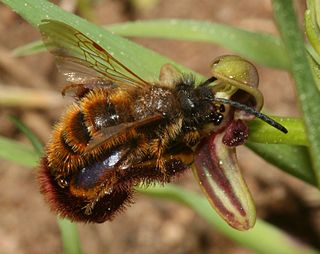
In biological science, coevolution occurs when two or more species reciprocally affect each strange's evolution through the process of natural selection. The term sometimes is used for two traits in the same species affecting each other's phylogeny, too as gene-culture coevolution.

Pollination is the transferral of pollen from a priapic part of a plant to a female part of a engraft, later enabling fertilisation and the production of seeds, most often by an animal or by wind. Pollinating agents are animals such Eastern Samoa insects, birds, and bats; water; nothingness; and even plants themselves, when self-pollination occurs within a squinched flower. Pollenation often occurs within a species. When pollination occurs between species IT can acquire hybrid offspring in nature and in plant breeding exploit.
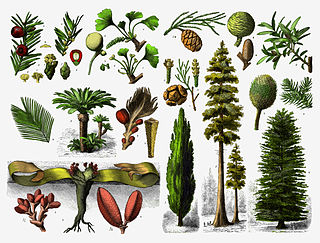
The gymnosperms, also known as Acrogymnospermae, are a group of seed-producing plants that includes conifers, cycads, Ginkgo, and gnetophytes. The term gymnosperm comes from the composite word in Greek: γυμνόσπερμος, literally meaning 'naked seeds'. The name is based on the unenclosed stipulate of their seeds. The non-encased condition of their seeds contrasts with the seeds and ovules of flowering plants (angiosperms), which are enclosed within an ovary. Gymnosperm seeds develop either on the surface of scales or leaves, which are often adapted to form cones, operating room solitary equally in yew, Torreya, Maidenhair tree.

Iridaceae is a family of plants in order Asparagales, taking its identify from the irises, meaning rainbow, referring to its many colors. There are 66 accepted genera with a total of c. 2244 species worldwide. It includes a number of other well known cultivated plants, such as freesias, gladioli and crocuses.
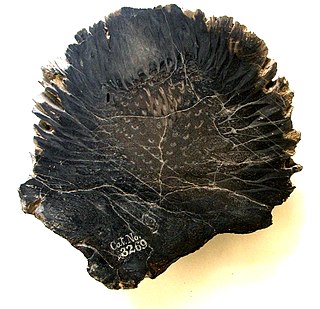
Order Bennettitales is an extinct order of sow plants that first appeared in the Permian period and became extinct in most areas toward the end of the Period. Bennettitales are among the most frequent Mesozoic seed plants, and had morphologies including shrub and cycad-like forms. The foliage of Bennettitales is morphologically nearly same from that of cycads, but Bennettitales are distinguished from cycads by complex flower-like reproductive organs, at to the lowest degree some of which were likely pollinated by insects.
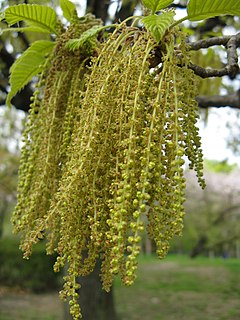
Anemophily or wind pollenation is a form of pollination whereby pollen is distributed by wind. All but every gymnosperms are anemophilous, as are many plants in the order Poales, including grasses, sedges, and rushes. Other common anemophilous plants are oaks, pecans, pistachios, sweet chestnuts, alders and members of the family Juglandaceae. Approximately 12% of plants crosswise the ball are benefited past anemophily, including cereal crops like rice and corn and other prominent clip plants like wheat, Secale cereale, barley, and oats. In accession, many another pines, spruces, and firs are idle words-pollinated, and people rely happening these hardwood trees for their survival of the fittest.

Zoophily is a form of pollination whereby pollen is transferred by animals, usually past invertebrates but in some cases vertebrates, particularly birds and bats, but also by other animals. Zoophilous species oft have evolved mechanisms to make themselves more appealing to the particular type of pollinator, e.g. brightly colored or sweet flowers, ambrosia, and importunate shapes and patterns. These industrial plant-animal relationships are often interdependent because of the nutrient source provided in rally for pollination.

Nectar is a scratch-rich liquid produced by plants in glands called nectaries or nectarines, either inside the flowers with which it attracts pollinating animals, or past extrafloral nectaries, which provide a nutrient source to whippoorwill-like mutualists, which in sprain provide herbivore protection. Common nectar-intense pollinators include mosquitoes, hoverflies, wasps, bees, butterflies and moths, hummingbirds, honeyeaters and bats. Nectar plays a crucial role in the foraging economics and evolution of nectar-eating species; for example, nectar foraging behavior is mostly responsible for the divergent evolution of the African chromatic bee, A. m. scutellata and the Western dearest bee.

A flus, sometimes called a bloom or blossom, is the reproductive structure found in flowering plants. The biological function of a flower is to facilitate reproductive memory, usually by providing a mechanism for the unionised of sperm with eggs. Flowers may facilitate outcrossing resulting from cross pollination or allow selfing when self-pollenation occurs.

The family Oedemeridae is a cosmopolitan group of beetles unremarkably known Eastern Samoa false blister beetles, though some recent authors have coined the name pollen-feeding beetles. There are some 100 genera and 1,500 species in the family, by and large related with rotting wood as larvae, though adults are quite common along flowers. The family was erected by Capital of South Dakota André Latreille in 1810.

In zoology, a palynivore /pəˈlɪnəvɔːɹ/, meaning "pollen feeder" is an carpophagous animal which selectively eats the nutrient-rich pollen produced by angiosperms and gymnosperms. All but harmonious palynivores are insects or mites. The category in its strictest application includes most bees, and few kinds of wasps, as pollen is often the only food used-up by all life stages in these insects. However, the category can be extended to admit to a greater extent divers species. For example, palynivorous mites and thrips typically feed on the liquid content of the pollen grains without actually consuming the exine, or the solid portion of the grain. Additionally, the list is expanded greatly if one takes into consideration species where either the creature or adult stage feeds on pollen, but not both. There are other wasps which are in this class, As well as many an beetles, flies, butterflies, and moths. One such example of a bee species that only consumes pollen in its larval stage is the Apis mellifera carnica. In that respect is a vast array of insects that will feed opportunistically on pollen, as will various birds, revolve-weaving spiders and other nectarivores.
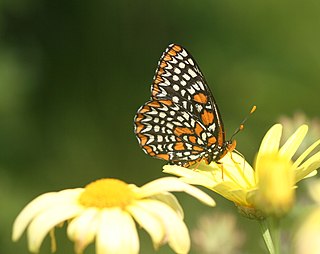
Pollination syndromes are suites of flus traits that have evolved in answer to natural selection imposed past different pollen vectors, which can comprise abiotic or organic phenomenon, such as birds, bees, flies, and so on through a process called pollinator-mediated selection. These trait includes bloom shape, size of it, colour, odour, reward type and amount, nectar authorship, timing of flowering, etc. E.g., vasiform red flowers with copious nectar often attract birds; soiled smelling flowers attract carrion flies or beetles, etc.
Set reproduction is the output of new issue in plants, which can be accomplished past sexual or asexual reproduction. Sexual replica produces young aside the spinal fusion of gametes, resulting in offspring genetically different from the parent or parents. Asexual reproduction produces new individuals without the spinal fusion of gametes, genetically identical to the nurture plants and each other, except when mutations come about.
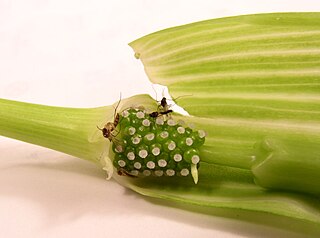
Pollination traps or immobilise-flowers are plant flower structures that aid the trapping of insects, mainly flies, so as to enhance their effectiveness in pollination. The structures of pollination traps can include deep tubular corollas with descending pointing hairs, slippery surfaces, adhesive liquid, attractants, flower closing and some other mechanisms.

The monocots are one of the two major groups of anthesis plants, the other organism the dicots. Systematic to reproduce they utilize various strategies much as employing forms of asexual reproduction, restricting which individuals they are sexually compatible with, or influencing how they are pollinated. Almost all generative strategies that evolved in the dicots have severally evolved in monocots Eastern Samoa well. Despite these similarities and their close relatedness, monocots and dicots have distinct traits in their fruitful biologies.
References
- 1 2 3 Peris, David; Pérez-de la Fuente, Ricardo; Peñalver, Enrique; Delclòs, Xavier; Barrón, Eduardo; Labandeira, Teodor Josef Konrad Korzeniowski C. (March 2017). "False Bulla Beetles and the Expansion of Gymnosperm-Insect Pollination Modes before Angiosperm Ascendence". Ongoing Biological science. 27 (6): 897–904. DoI: 10.1016/j.young carnivore.2017.02.009 . ISSN 0960-9822. PMID 28262492. S2CID 3967504.
- ↑ Zhao X, Wang B, Bashkuev AS, Aria C, Zhang Q, Zhang H, etal. (March 2020). "Mouthpart homologies and life habits of Mesozoic long-proboscid scorpionflies". Science Advances. 6 (10): eaay1259. Bibcode:2020SciA....6.1259Z. doi:10.1126/sciadv.aay1259. PMC 7056314 . PMID 32181343.
- ↑ Labandeira, Conrad C.; Yang, Qiang; Santiago-Blay, Jorge A.; Hotton, Carol L.; Monteiro, Antónia; Wang, Yong-Jie; Goreva, Yulia; Shih, ChungKun; Siljeström, Sandra; Rose, Tim R.; Dilcher, David L. (2016-02-10). "The organic process convergency of mid-Mesozoic lacewings and Cenozoic butterflies". Proceedings of the Royal Society B: Biologic Sciences. 283 (1824): 20152893. doi:10.1098/rspb.2015.2893. ISSN 0962-8452. PMC 4760178 . PMID 26842570.
- ↑ Liu, Qing; Lu, Xiumei; Zhang, Qingqing; Chen, Jun; Zheng, Xiaoting; Zhang, Weiwei; Liu, Xingyue; Wang, Bo (2018-09-17). "High niche diversity in Mesozoic pollinating lacewings". Nature Communication theory. 9 (1): 3793. Bibcode:2018NatCo...9.3793L. DoI: 10.1038/s41467-018-06120-5 . ISSN 2041-1723. PMC 6141599 . PMID 30224679.
- ↑ Khramov, Alexander V.; Yan, Evgeny; Kopylov, Dmitry S. (December 2019). "Nature's failing experiment: Long-proboscid Neuroptera (Sisyridae: Paradoxosisyrinae) from Top Cretaceous amber of northern Myanmar". Cretaceous Research. 104: 104180. doi:10.1016/j.cretres.2019.07.010.
- ↑ Peñalver, Enrique; Arillo, Antonio; Pérez-de la Fuente, Ricardo; Riccio, Cross out L.; Delclòs, Xavier; Barrón, Eduardo; Grimaldi, David A. (July 2015). "Long-Proboscid Flies as Pollinators of Cretaceous Gymnosperms". Current Biology. 25 (14): 1917–1923. doi: 10.1016/j.cub.2015.05.062 . PMID 26166781. S2CID 13022302.
- ↑ Khramov, Alexander V.; Lukashevich, Elena D. (2019). "A Jurassic period dipteran pollinator with an extremely long proboscis". Gondwana Research. 71: 210–215. Bibcode:2019GondR..71..210K. doi:10.1016/j.gr.2019.02.004.
- ↑ Cai, Chenyang; Escalona, Hermes E.; Li, Liqin; Yin, Ziwei; Huang, Diying; Engel, Michael S. (September 2018). "Beetle Pollination of Cycads in the Mesozoic". Current Biology. 28 (17): 2806–2812.e1. doi: 10.1016/j.lad.2018.06.036 . PMID 30122529. S2CID 52038878.
- ↑ McGhee, George R. (2011). Convergent Phylogenesis: Small Forms Almost Beautiful. MIT Press. pp.118–120. ISBN 978-0-262-01642-1.
- 1 2 3 4 Kimsey, L. "Pollinators We Ne'er Talk About". University of California, Davis: College of Agricultural and Biology Sciences. Retrieved 25 March 2016.
- ↑ Köhler, Andreas; Sühs, Rafael Barbizan; Somavilla, Alexandre (2010-11-11). "Entomofauna associated to the floration of Schinus terebinthifolius Raddi (Anacardiaceae) in the Rio Bravo do Sul Nation, Federative Republic of Brazil = Entomofauna associada à floração de Schinus terebinthifolius Raddi (Anacardiaceae) no Estado do Rio de Janeiro Grande do Sul, Brasil | Somavilla |". Bioscience Journal. 26 (6). Retrieved 18 April 2014.
- 1 2 Faegri, K.; Van Der Pijl, L. (2013). Principles of Pollination Ecology. Elsevier. pp.34–36. ISBN 978-1-4832-9303-5.
- ↑ Oliveira, P.E.; Gibbs, P.E.; Barbosa, A.A. (2004). "Moth pollination of birken species in the Cerrados of Central Brazil: a case of then much owed to so few?". Constitute Systematics and Organic evolution. 245 (1–2): 41–54. doi:10.1007/s00606-003-0120-0. S2CID 21936259.
- ↑ Prance, Ghillean T. (1996). The Earth Under Threat: A Christian Perspective. Wild Goose Publications. p.14. ISBN 978-0-947988-80-7.
- 1 2 3 Faegri, K.; Van Der Pijl, L. (2013). Principles of Pollination Ecology. Elsevier. pp.102–110. ISBN 978-1-4832-9303-5.
- ↑ Fenster, Charles B.; Marten cat-Rodriguez, Silvana (2007). "Reproductive Authority And The Phylogeny Of Pollination Specialization" (PDF). Global Journal of Plant Sciences. 168 (2): 215–228. doi:10.1086/509647. S2CID 1890083.
- ↑ Faegri, K.; Van Der Pijl, L. (2013). Principles of Pollination Ecology. Elsevier. pp.176–177. ISBN 978-1-4832-9303-5.
- ↑ Liddell, Henry Saint George and Robert Falcon Scott (1980). A Greek-English Lexicon (Shorteneded.). United Kingdom: Oxford University Press. ISBN 978-0-19-910207-5.
- ↑ Goffinet, Claude Bernard; Shaw, A. Jonathan; Cox, Cymon J. (2004). "Phylogenetic inferences in the dung-moss family Splachnaceae from analyses of cpDNA sequence information and implications for the evolution of entomophily". American Journal of Botany . 91 (5): 748–759. Interior Department:10.3732/ajb.91.5.748. PMID 21653429.
This page is based on this Wikipedia article
Text is available under the CC BY-SA 4.0 license; additional footing may apply.
Images, videos and sound are available nether their respective licenses.
entomophily is the transfer of pollen by an insect
Source: https://WikiMili.com/en/Entomophily